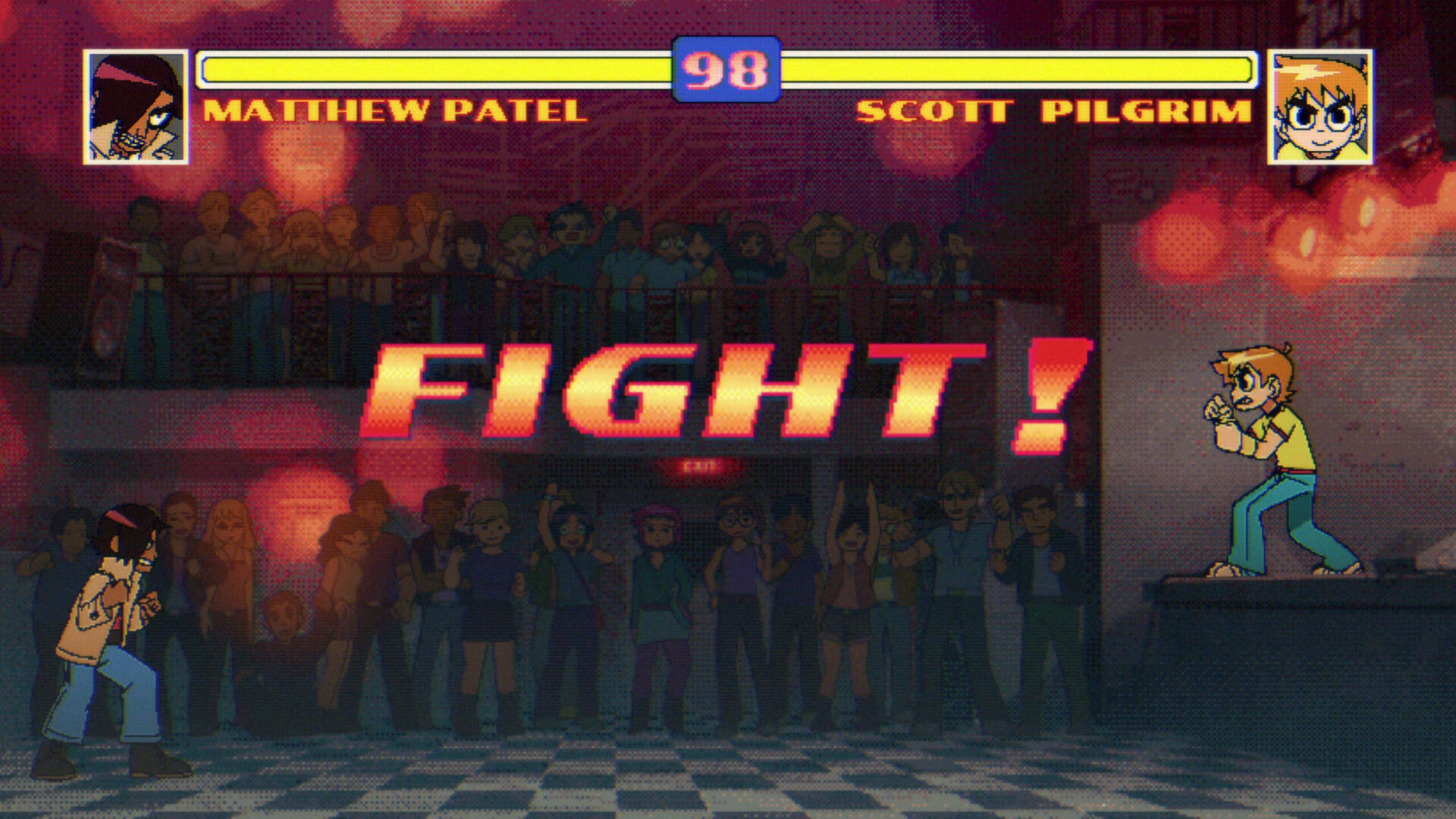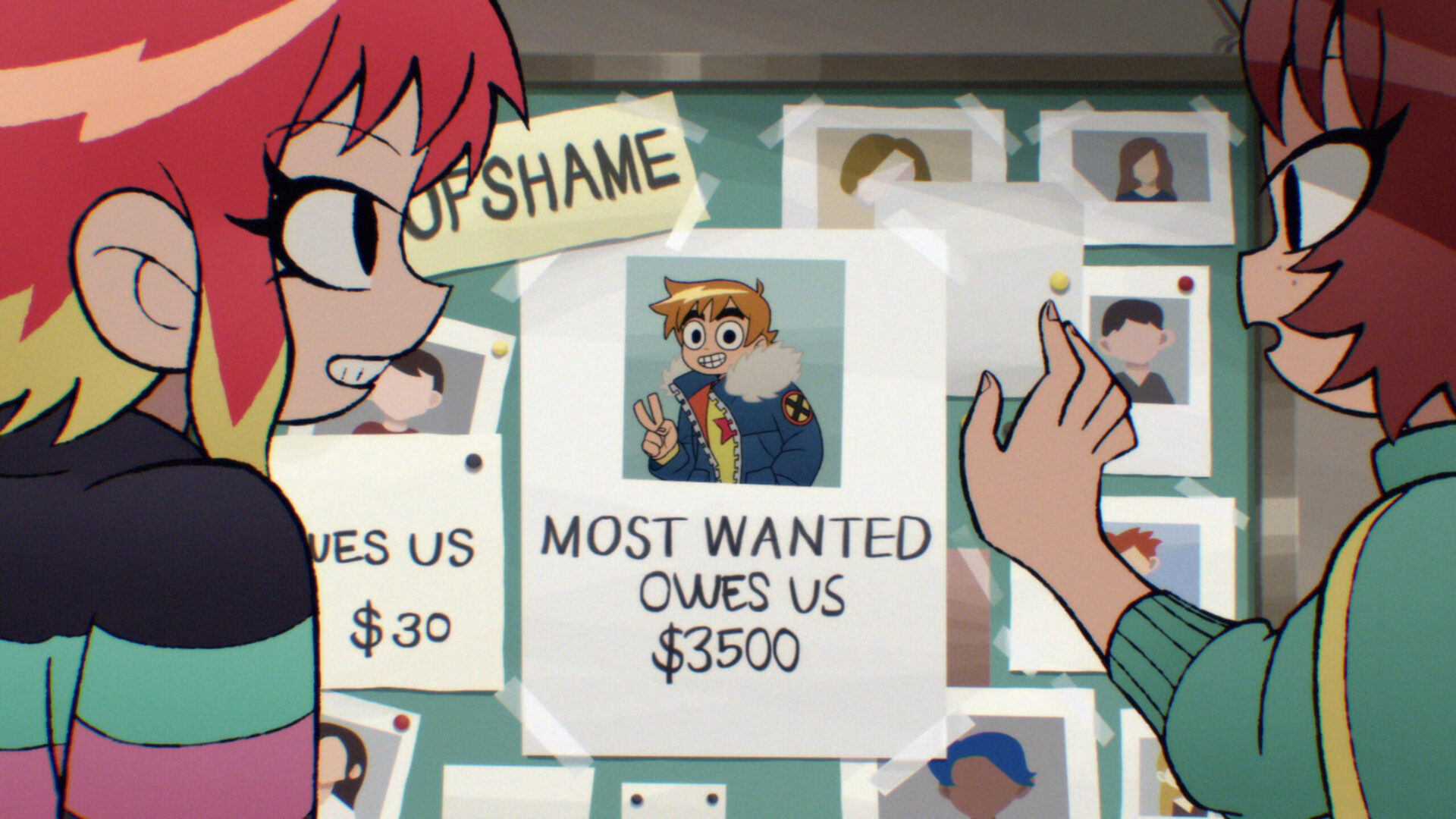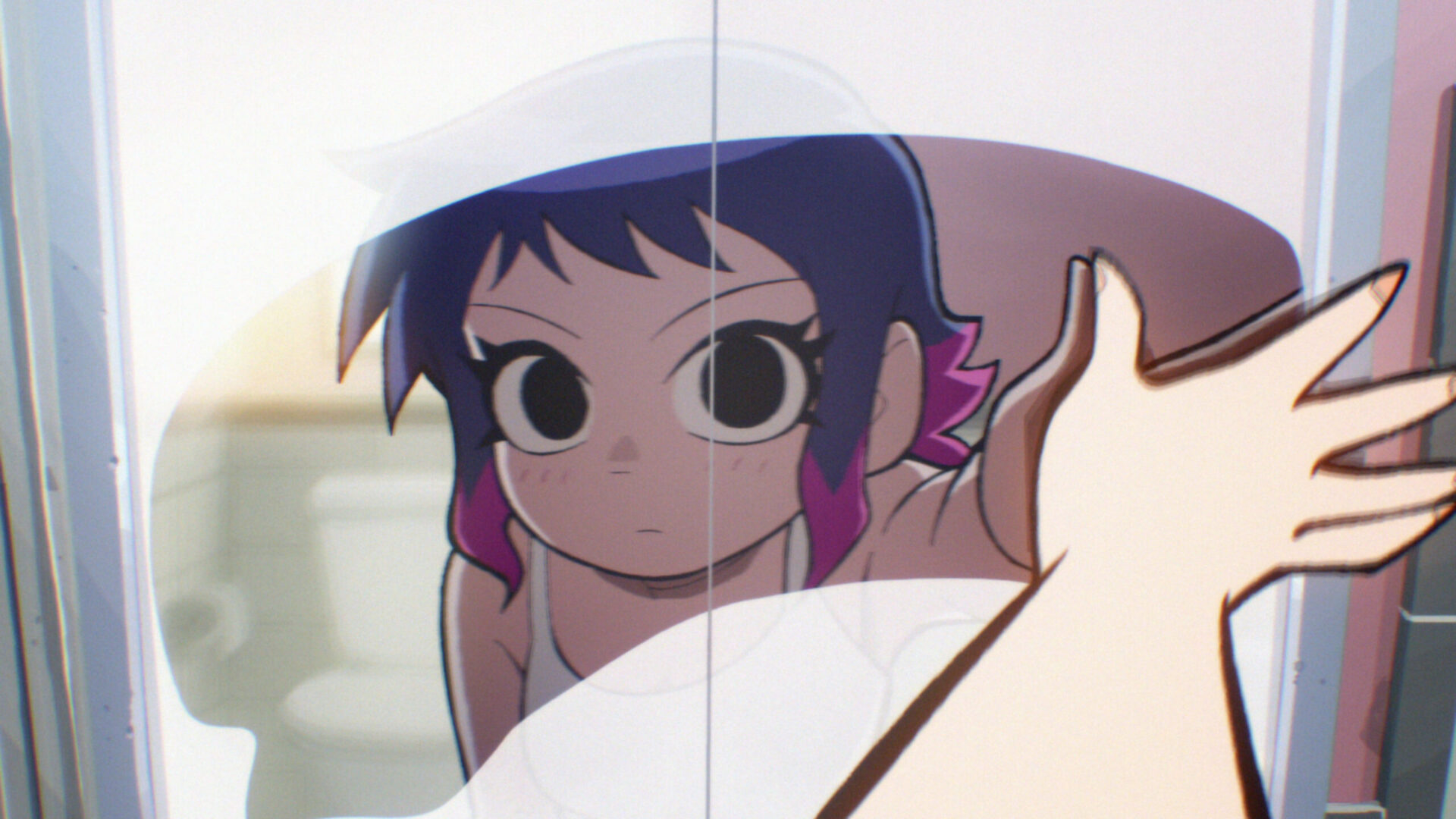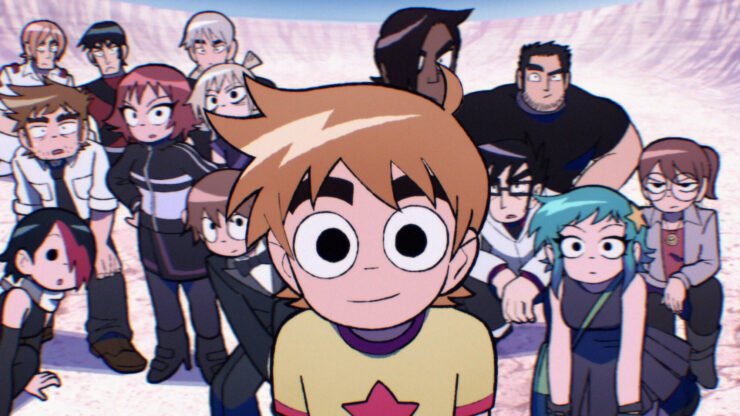The week that Scott Pilgrim Takes Off was set to come out, I went to the bookstore to fill in my scattered Scott Pilgrim collection, thinking I’d at least page through the books after watching the new anime adaptation. After a single episode of the series, I tossed that idea out the window.
There will be spoilers, but until the spoiler warning, only the first episode will be spoiled. Got that?
Scott Pilgrim creator Bryan Lee O’Mally and his co-showrunner BenDavid Grabinski have been notably tight-lipped about their anime adaptation (brought to glorious life by the studio Science SARU). “If you think you know what you’re going to see, you don’t,” Grabinski told the LA Times. This contrasted oddly with the trailers, which made it look like we’d be on familiar ground: Scott (Michael Cera) meets the literal girl of his dreams, Ramona Flowers (Mary Elizabeth Winstead), and then discovers he has to fight her seven evil exes before he can date her.
That is not what happens in Scott Pilgrim Takes Off. What happens here is new, and fresh, and deeply resonant for those of us who have been following this story for nearly two decades. It’s also a brilliant example of what adaptations do at their best: find new depths and new meanings in a story we think we know.
In that first episode, we re-meet the whole cast of the 2010 Edgar Wright movie adaptation, now providing voices to the animated version: Cera, Winstead, Kieran Culkin (as Scott’s cool gay roommate, Wallace Wells); Brie Larson (as Scott’s rock star ex, Envy Adams); Chris Evans (as bro-tastic actor Lucas Lee); Brandon Routh (as powerful vegan Todd Ingram); Aubrey Plaza (as foul-mouthed Julie Powers); Satya Bhabha (as evil ex Matthew Patel); and everyone else from the film.
Scott dreams of Ramona, meets her at a party, and contrives a patently absurd but effective way to see her again (by ordering a Netflix DVD; Ramona’s job has been updated). They go on a date that goes well enough that Ramona agrees to come see Scott’s band, Sex Bob-Omb. The whole gang is there, including Scott’s not-girlfriend, the 17-year-old Knives Chau (Ellen Wong).
One of the first big signs that something is different here is that we never get to see the band Crash and the Boys (“I’m soooooooo SAD!”), who bail on their opening slot.
The next is that Scott loses his first evil ex fight with Matthew Patel.

For a long minute, I thought this was some kind of… animated prank. Scott loses? How can Scott Pilgrim be defeated—vanquished, vanished—in a story with his name in the title? But then, said title does kind of tell us what happens: Scott takes off. Not as in rocketship. As in gone.
This is, as O’Malley and Grabinski promised, not the Scott Pilgrim story you expect, if you expect the books or the movie. If you expect, or hope, that an adaptation will transform its material into something new, well, this is a pitch-perfect example of that. So much is new, from the music (from Anamanaguchi and composer Joseph Trapanese) to the way we meet most of Ramona’s exes to the way their pasts are explored. But it also honors what came before: Iconic lines get remixed into new scenarios, video game references abound, and even the original source of the name Scott Pilgrim—a song by the Canadian indie band Plumtree—has a perfect moment in the sun.
I could never have guessed this was the Scott Pilgrim we were getting, and yet now that it’s happened, nothing could make more sense. The best clue as to what O’Malley and Grabinski do here is in that LA Times interview:
“We’re trying to get into people’s heads more,” said O’Malley. “Because when I was 25 years old, I didn’t know what these people were feeling necessarily. But I’ve seen a lot more life and I have more context for those characters now.”
This is an adaptation that is all about adding context, and about understanding the characters that were once peripheral to Scott Pilgrim’s precious little life. Twenty years ago, Scott’s narrative was fresh and unusual: Who was telling stories about indie-rock dudes in Toronto, let alone through a video-game, anime-tinged lens, through O’Malley’s specific combination of experiences and perspectives?
But we’ve been there. We’ve read and watched that. For the new Scott Pilgrim, O’Malley and Grabinski (and director Abel Góngora and everyone at Science SARU) have found a way to apply twenty years of growing up to this story, while still letting these characters be who they are. The result is a delightfully energetic, deeply felt new version—not a remix, not a cover, not a reboot. If anything, it feels like a different timeline, one that complements and reflects the story as we knew it.
Here’s where the spoilers start.

Not everyone gets a thorough revisiting. The other members of Sex Bob-Omb are, largely, themselves, though my favorite episode is the third one, where Ramona goes to talk to Kim Pine (Alison Pill) at her video store job. Evil ex Roxie Richter (Mae Whitman) turns up, and the fight she has with Ramona bounces through an impressively animated series of movie-referencing scenes, winding up where it had to all along: in recognition that no matter how many epic battles you might have, there is no winning at feelings. There is only facing them, processing them, getting through them, and finding yourself (hopefully) on your feet afterwards. (Roxie is nothing if not resilient.)
But even in the smallest of strokes, the show gives characters new layers. Knives gets her own arc, part of which is becoming a member of Sex Bob-Omb, because it turns out she’s really good at music. The way this realization is animated—pulsing stars, a blissful glow, shooting colors—made me absolutely swoon. Even perpetually grumpy Kim looks happy when she’s playing drums with Knives.
This show, though, belongs to Ramona. After Scott’s funeral (which Envy Adams crashes for a spectacular performance), Ramona dreams about Scott, on account of how she’s quite familiar with the subspace highway that runs through his head. (Just roll with it.) Is he really dead? Or did something else happen in the final moments in his fight with Matthew? Figuring out what’s going on entails talking to her exes, all of whom are suspects in Scott’s disappearance.
It’s an almost High Fidelity-ish concept, except for one major difference: Ramona’s trips down memory lane aren’t about her. They’re about Scott, and they’re about how we play more than one role in each relationship in our lives. Who walks away from whom? Who internalizes the pain and who lets it go? Who wants to fight it out and who wants to forgive? How often are these opposites embodied in the same person?
Scott Pilgrim Takes Off is a story about growth. It’s about emotional maturity, and how there’s no shortcut to earning said maturity. You just have to come to terms with things, step by step, one moment at a time. And yet it’s an absolutely hilarious, clever, imaginative, twisty, loving tale, too.
Also, there’s an episode called “2 Scott 2 Pilgrim,” and that’s just gold by itself.
I cannot say enough about how perfectly this show walks a very difficult line: Honoring what came before while also telling a new, more modern, more egalitarian story. O’Malley and Grabinski aren’t here to lecture, or to send up Scott, or to try to be clever at the expense of any of the characters O’Malley created in his 20s. They never condescend to these characters, even when Scott’s older self appears. Old Scott is a cautionary tale, a look at what might happen to someone who refuses to accept the complexities and pain of growing up. (If there is one question I still have, it’s how Old Scott, having spent 13 years with Ramona, could still be so emotionally stunted. But I can let that one quibble slide.)
On the other hand, there’s Ramona, who accepts it all: who she was, who she is, who she will eventually be.
There’s so much to take in: There’s the elevation of would-be theater star Matthew (who gets a great Into the Woods reference); there’s the much broader range of queer relationships; there’s the aforementioned justice for Knives, who retains her teenage enthusiasm but gets respect, too. And every time Ramona’s hair changes color, we watch her change it, step by step. Bleach, rinse, color, rinse. Nothing comes without effort, least of all change.

When Bryan Lee O’Malley published the first Scott Pilgrim book in 2004, he, like his protagonist, was in his 20s. I was in my 20s, too, when I read the books, recognizing so many types, so many things about the people I knew—so much I once simply accepted or took for granted. Getting to watch this story transform the way so many of us have ourselves transformed is unexpected—and unexpectedly powerful. The oldest version of Scott that we meet is a nightmare, a man absolutely stuck on his past self—still trying to fight, to win, in a situation that calls for a wildly different approach. The climactic battle is absurd, silly, almost awkward, and I see it as a commentary on how just doing the same story over again might have felt in the year 2023. Haven’t we learned anything? Can we accept the people we once were, the stories we once told or loved, and incorporate those things into a greater whole? Haven’t we learned enough to try it a different way?
Within Scott Pilgrim Takes Off, Scott’s story appears over and over again, adapted within this adaptation: a movie (directed by Edgar Wrong), a documentary about the movie, a musical, a memoir. One or two of these stories may or may not have been written by the ditzy Young Neil (Johnny Simmons, just killing the voice role, wispy and spaced out). And while all of it is clever and hilarious and full of cameos and jokes, it’s also a reminder that we tell ourselves stories that are, essentially, versions of ourselves. If two people have an encounter, the stories they tell about it afterward won’t be the same.
Scott Pilgrim Takes Off is just full of everyone else’s stories, and their flaws, and their unexpected loves (even the evil exes!). Like Scott in the original stories, Ramona has her own failings to come to terms with. She may be a hot rollerblading literal dream girl, but she’s far from perfect. What she finds, while looking for Scott, is something it often takes us years to figure out: the repeated mistakes she made in her past. She looks at them, and takes them in, and moves forward, while Old Scott just… doesn’t. His entire existence is the opposite of what the show is doing. The enemy is stagnation.

I don’t know if this show, thematically, will speak to anyone as clearly as it’s going to speak to those of us who are roughly the same age as O’Malley, who met Scott in our 20s and are in our 40s now. We know how we got here, how much time we spent getting hurt, or losing our way, or having things not turn out like we wanted them to or hoped they would. We know what the series doesn’t have time to show: the stages between the blissful, lighting-up-the-world beginning of a relationship and the time when it gets tough. And many of us are probably all too familiar with the difference between acceptance and refusal. Anyone could be Even Older Scott, if they’re not careful.
What I am saying, then, is that while Scott Pilgrim was, and is, fundamentally a story about growing up, Scott Pilgrim Takes Off just extends itself. Growing up is not a one-time process. You’ve just got to keep doing it.
All this, and there’s more: There are countless video game references (more than one of them about Sonic the Hedgehog), movie and TV references (Kill Bill! David Cronenberg’s Crash! Columbo!), anime in-jokes, and a kinetic brilliance that only animation could provide. (Also, the robot!) It’s the way things shift focus, the blocky ends of characters’ hands, the dramatic expressions and inventive fights. Science SARU created a new visual language for Scott Pilgrim, one drawn from the books but with nods to the movie. Layers of collaboration built this project, which feels fitting: What was a story about and created by one young man has grown into an ensemble cast, created by multiple ensembles of creatives. This is what animated takes on beloved stories are capable of, at their best; this is what is possible when you revisit old stories with a generous heart and an open mind.
Scott Pilgrim has always been good. Scott Pilgrim has also never been better.
Molly Templeton lives and writes in Oregon, and spends as much time as possible in the woods. Sometimes she talks about books on Twitter.










